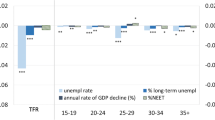Abstract
To shed light on the economic-demographic mechanisms operating in the epoch of pre-industrial economic stagnation, a two-sector Malthusian model is formulated in terms of a cointegrated vector autoregressive model on error correction form. The model allows for both agricultural product wages and relative prices to affect fertility. The model is estimated using new data for the pre-industrial period in England, and the analysis reveals a strong, positive effect of agricultural wages as well as a nonnegative effect of real agricultural prices on fertility. Furthermore, it is demonstrated that there is strongly decreasing returns to scale with respect to labour in the agricultural sector and approximately constant returns to scale in the manufacturing sector. The analysis provides evidence in favour of the usual Malthusian model, as invoked by unified growth theories such as e.g. Galor and Weil (Am Econ Rev 90:806–828, 2000).

Similar content being viewed by others
Notes
Weisdorf (2008) sets φ = γ = 1.
Weisdorf (2008) assumes μ = 0.
I use the large residual detection of outliers instead of the dummy saturation procedure because the former is able to detect the temporary effect of the famine in 1727–1728.
A VAR model with too few lags tend to produce autocorrelated residuals (see for example Juselius 2006 p. 72). In the present case, autocorrelation is not a problem, indicating that a lag length of 1 is suitable.
Furthermore, the interpretation of the coefficients in the β matrix changes.
References
Appleby AB (1980) Epidemics and famine in the little ice age. J Interdiscip Hist 10:643–663
Ashraf Q, Galor O (2011) Dynamics and Stagnation in the Malthusian Epoch. American Economic Review 101:2003–2041
Broadberry S, Campbell B, Klein A, Overton M, Van Leeuwen B (2011) British economic growth, 1300–1850: some preliminary estimates. In: Paper presented at the workshop quantifying long-run economic development in Venice, 22–24 March 2011
Clark G (2005) The condition of the working class in England, 1209–2004. J Political Econ 113:1307–1340
Clark G (2007) The long march of history: farm wages, population and economic growth, England 1209–1869. Econ History Rev 60:97–135
Crafts N, Mills TC (2009) From malthus to solow: how did the Malthusian economy really evolve. J Macroecon 31:68–93
Crafts NFR (1985) British economic growth during the industrial revolution. The Clarendon Press, Oxford University Press, New York
Dennis JG (2006) CATS in RATS: cointegration analysis of time series. Estima
Doornik JA (2009) Autometrics. In: The methodology and practice of econometrics: a festschrift in honour of David F. Hendry. Oxford University Press, Oxford, pp 88–121
Doornik JA, Hendry DF (2009) PcGive 13. Timberlake Consultants Press, London
Galloway PR (1988) Basic patterns in annual variations in fertility, nuptiality, mortality, and prices in pre-industrial Europe. Popul Stud 42:275–402
Galor O, Weil DN (2000) Population, technology, and growth: from Malthusian stagnation to the demographic transition and beyond. Am Econ Rev 90:806–828
Johansen S (1995) Likelihood-based inference in the cointegrated vector autoregressive models. Oxford University Press, Oxford
Juselius K (2006) The cointegrated VAR model: methodology and applications. Oxford University Press, Oxford
Klemp MPB, Weisdorf JL (2011) The child quantity-quality trade-off during the industrial revolution in England. Discussion papers 11–16, University of Copenhagen, Department of Economics
Klemp MPB, Weisdorf JL (forthcoming) The lasting damage to mortality of early-life adversity: evidence from the English famine of the late 1720. European review of economic history
Lee R, Anderson M (2002) Malthus in state space: macro economic-demographic relations in English history, 1540–1870. J Popul Econ 15:195–220
Lee RD (1985) Inverse projection and back projection: a critical appraisal, and comparative results for England, 1539–1871. Popul Stud 39:233–248
Luterbacher J, Dietrich D, Xoplaki E, Grosjean M, Wanner H (2004) European seasonal and annual temperature variability, trends, and extremes since 1500. Science 303:1499–1503
Møller NF (2008) Bridging economic theory models and the cointegrated vector autoregressive model. Economics: the open-access, open-assessment E-Journal 2
Møller NF, Sharp P (2008) Malthus in cointegration space: a new look at living standards in pre-industrial England. Working paper
Nicolini EA (2007) Was malthus right? A VAR analysis of economic and demographic interactions in pre-industrial England. Eur Rev Econ History 11:99–121
Post JD (1984) Climatic variability and the European mortality wave of the early 1740s. J Interdiscip History 15:1–30
Strulik H, Weisdorf J (2008) Population, food, and knowledge: a simple unified growth theory. J Econ Growth 13:195–216
Weisdorf JL (2008) Malthus revisited: fertility decision making based on quasi-linear preferences. Econ Lett 99:127–130
Wrigley EA, Davies R, Schofield RS (1997) English population history from family reconstitution. Cambridge University Press, Cambridge
Wrigley EA, Schofield RS (1981) The population history of England 1541–1871. Edward Arnold Ltd, Cambridge
Acknowledgments
I am grateful to Marie G. Gaardmark, Oded Galor, Bas van Leeuwen, Jacob L. Weisdorf, and particularly Niels F. Møller for helpful comments and discussions. Remaining errors are mine.
Author information
Authors and Affiliations
Corresponding author
Additional information
An erratum to this article can be found at http://dx.doi.org/10.1007/s11698-012-0080-0.
Rights and permissions
About this article
Cite this article
Klemp, M.P.B. Prices, wages and fertility in pre-industrial England. Cliometrica 6, 63–77 (2012). https://doi.org/10.1007/s11698-011-0072-5
Received:
Accepted:
Published:
Issue Date:
DOI: https://doi.org/10.1007/s11698-011-0072-5




